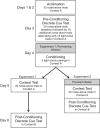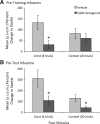CGRP antagonist infused into the bed nucleus of the stria terminalis impairs the acquisition and expression of context but not discretely cued fear
- PMID: 24255102
- PMCID: PMC3834624
- DOI: 10.1101/lm.032482.113
CGRP antagonist infused into the bed nucleus of the stria terminalis impairs the acquisition and expression of context but not discretely cued fear
Abstract
Calcitonin gene-related peptide (CGRP) infusions into the bed nucleus of the stria terminalis (BNST) evoke increases in startle amplitude and increases in anxiety-like behavior in the plus maze. Conversely, intra-BNST infusions of the CGRP antagonist CGRP₈₋₃₇ block unconditioned startle increases produced by fox odor. Here we evaluate the contribution of CGRP signaling in the BNST to the development and expression of learned fear. Rats received five pairings of a 3.7-sec light and footshock and were tested for fear-potentiated startle one or more days later. Neither pre-training (Experiment 1) nor pre-test (Experiment 2) infusions of the CGRP antagonist CGRP₈₋₃₇ (800 ng/BNST) disrupted fear-potentiated startle to the 3.7-sec visual cue. However, in both experiments, CGRP₈₋₃₇ infusions disrupted baseline startle increases that occurred when rats were tested in the same context as that in which they previously received footshock (Experiment 3). Intra-BNST CGRP₈₋₃₇ infusions did not disrupt shock-evoked corticosterone release (Experiment 4). These data confirm previous findings implicating BNST CGRP receptors in fear and anxiety. They extend those results by showing an important contribution to learned fear and, specifically, to fear evoked by a shock-associated context rather than a discrete cue. This pattern is consistent with previous models of BNST function that have posited a preferential role in sustained anxiety as opposed to phasic fear responses. More generally, the results add to a growing body of evidence indicating behaviorally, possibly clinically, relevant modulation of BNST function by neuroactive peptides.
Figures






Similar articles
-
Calcitonin gene-related peptide in the bed nucleus of the stria terminalis produces an anxiety-like pattern of behavior and increases neural activation in anxiety-related structures.J Neurosci. 2011 Feb 2;31(5):1802-10. doi: 10.1523/JNEUROSCI.5274-10.2011. J Neurosci. 2011. PMID: 21289190 Free PMC article.
-
Role of bed nucleus of the stria terminalis and amygdala AMPA receptors in the development and expression of context conditioning and sensitization of startle by prior shock.Brain Struct Funct. 2014 Nov;219(6):1969-82. doi: 10.1007/s00429-013-0616-5. Epub 2013 Aug 11. Brain Struct Funct. 2014. PMID: 23934654 Free PMC article.
-
Anxiogenic effects of CGRP within the BNST may be mediated by CRF acting at BNST CRFR1 receptors.Behav Brain Res. 2013 Apr 15;243:286-93. doi: 10.1016/j.bbr.2013.01.024. Epub 2013 Feb 1. Behav Brain Res. 2013. PMID: 23376701 Free PMC article.
-
Selective participation of the bed nucleus of the stria terminalis and CRF in sustained anxiety-like versus phasic fear-like responses.Prog Neuropsychopharmacol Biol Psychiatry. 2009 Nov 13;33(8):1291-308. doi: 10.1016/j.pnpbp.2009.06.022. Epub 2009 Jul 10. Prog Neuropsychopharmacol Biol Psychiatry. 2009. PMID: 19595731 Free PMC article. Review.
-
Pharmacological analysis of fear-potentiated startle.Braz J Med Biol Res. 1993 Mar;26(3):235-60. Braz J Med Biol Res. 1993. PMID: 8257926 Review.
Cited by
-
Extending the amygdala in theories of threat processing.Trends Neurosci. 2015 May;38(5):319-29. doi: 10.1016/j.tins.2015.03.002. Epub 2015 Apr 4. Trends Neurosci. 2015. PMID: 25851307 Free PMC article. Review.
-
Chemoarchitecture of the bed nucleus of the stria terminalis: Neurophenotypic diversity and function.Handb Clin Neurol. 2021;179:385-402. doi: 10.1016/B978-0-12-819975-6.00025-X. Handb Clin Neurol. 2021. PMID: 34225977 Free PMC article. Review.
-
Reversible Inactivation of the Bed Nucleus of the Stria Terminalis Prevents Reinstatement But Not Renewal of Extinguished Fear.eNeuro. 2015 Jul 3;2(3):ENEURO.0037-15.2015. doi: 10.1523/ENEURO.0037-15.2015. eCollection 2015 May-Jun. eNeuro. 2015. PMID: 26464990 Free PMC article.
-
Manual segmentation of the paraventricular nucleus of the hypothalamus and the dorsal and ventral bed nucleus of stria terminalis using multimodal 7 Tesla structural MRI: probabilistic atlases for a stress-control triad.Brain Struct Funct. 2024 Mar;229(2):273-283. doi: 10.1007/s00429-023-02713-z. Epub 2023 Oct 9. Brain Struct Funct. 2024. PMID: 37812278 Free PMC article.
-
Role of the bed nucleus of the stria terminalis in the acquisition of contextual fear at long or short context-shock intervals.Behav Neurosci. 2015 Oct;129(5):673-8. doi: 10.1037/bne0000088. Epub 2015 Sep 7. Behav Neurosci. 2015. PMID: 26348716 Free PMC article.
References
-
- Aerni A, Traber R, Hock C, Roozendaal B, Schelling G, Papassotiropoulos A, Nitsch RM, Schnyder U, de Quervain DJ 2004. Low-dose cortisol for symptoms of posttraumatic stress disorder. Am J Psychiatry 161: 1488–1490 - PubMed
-
- Alheid GF, Heimer L 1988. New perspectives in basal forebrain organization of special relevance for neuropsychiatric disorders: The striatopallidal, amygdaloid, and corticopetal components of substantia innominata. Neuroscience 27: 1–39 - PubMed
-
- Alheid G, De Olmos JS, Beltramino CA 1995. Amygdala and extended amygdala. In The rat nervous system (ed. Paxinos G), pp. 495–578 Academic Press, New York
-
- Ali AE, Wilson YM, Murphy M 2012. Identification of neurons specifically activated after recall of context fear conditioning. Neurobiol Learn Mem 98: 139–147 - PubMed
Publication types
MeSH terms
Substances
Grants and funding
- P51 OD011132/OD/NIH HHS/United States
- MH080330/MH/NIMH NIH HHS/United States
- P51 RR000165/RR/NCRR NIH HHS/United States
- P51OD011132/OD/NIH HHS/United States
- P51RR000165/RR/NCRR NIH HHS/United States
- U19 MH069056/MH/NIMH NIH HHS/United States
- R01 MH047840/MH/NIMH NIH HHS/United States
- MH47840/MH/NIMH NIH HHS/United States
- MH093023/MH/NIMH NIH HHS/United States
- R37 MH047840/MH/NIMH NIH HHS/United States
- F32 MH093023/MH/NIMH NIH HHS/United States
- MH069056/MH/NIMH NIH HHS/United States
- R01 MH080330/MH/NIMH NIH HHS/United States
LinkOut - more resources
Full Text Sources
Other Literature Sources
Research Materials
